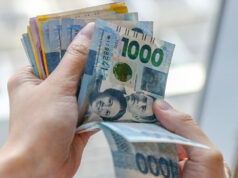RBA pauses rates for 4th month as Bullock’s debut signals continuity

SYDNEY — Australia’s central bank held interest rates steady on Tuesday for a fourth month and showed no urgency to hike again, although it repeated a warning that further tightening might be needed to bring inflation to heel in a “reasonable timeframe.”
Wrapping up its October policy meeting, the first chaired by Governor Michele Bullock, the Reserve Bank of Australia (RBA) held rates at 4.10%, and said recent data were consistent with inflation returning to its 2-3% target over time with output and employment still growing.
Markets and economists had wagered on a steady outcome after a batch of economic data — including inflation, retail sales and job vacancies — did not materially change the interest rate outlook.
The Australian dollar slumped to a fresh 11-month low of $0.6315 after the rate decision, while markets moved to slightly reduce the chance of a hike in November to 36%, compared with 44% before.
A number of economists had looked for some change in the governor’s statement under Ms. Bullock, but it remained almost identical to the previous meeting and suggested the new central bank chief isn’t inclined to rock the boat.
“There was really very little in today’s statement, nothing really new in the statement. It is clear the tightening bias remains, but it is also clear given it’s been four steady rate decisions in a row that the hurdle to hike further is pretty high,” said Su-Lin Ong, chief economist at RBC Capital Markets.
“I don’t think Michele Bullock is all that different to Philip Lowe… They don’t really want to have to tighten any more and they’re prepared to tolerate a slower return to within target inflation.”
Ms. Bullock stressed that inflation, while still too high, is projected to come down and economic growth remained below trend despite the slightly stronger-than-expected first half outcome.
“Some further tightening of monetary policy may be required to ensure that inflation returns to target in a reasonable timeframe, but that will continue to depend upon the data and the evolving assessment of risks,” Ms. Bullock said.
Over the month, inflation ticked up as expected due to petrol prices, job vacancies tumbled from historically high levels and consumer spending stayed subdued, suggesting the rate hikes so far are working to cool demand in the economy.
Q3 INFLATION TEST
Some economists have penciled in a rate hike in November depending on the result of the third-quarter inflation report.
“Looking ahead, the September quarter inflation figures due this month will weigh heavily on the next meeting of the RBA Board,” said Pradeep Philip, head of Deloitte Access Economics.
“All eyes will be on whether every inflation data point is a nail for the RBA interest rate hammer.”
Overseas, a surge in global bond yields is also tightening financial conditions, lessening the pressure on central banks to hike further.
Indeed, global central banks, led by the US Federal Reserve, have started to slow their sweeping tightening campaign as inflation has come off alarmingly high levels. Yet, markets are betting that interest rates will stay higher for longer, with no rate cuts priced in next year for the RBA.
The RBA has jacked up interest rates by a whopping 400 basis points since May last year, and the latest assessment is that it sees a credible path where inflation can return to the bank’s 2-3% target band in late 2025 with the cash rate at 4.1%. — Reuters



